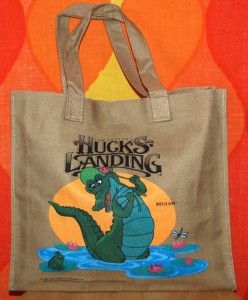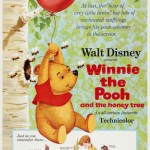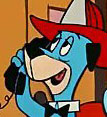 Getting Beer for Fred Moore. While Paul Murry is perhaps most famous for his comic book work, especially the Mickey Mouse serials in Walt Disney’s Comics and Stories, he got his start as the animation assistant for Disney Legend Fred Moore in 1938. This is from a letter Murry wrote to my friend Wayne DeWald in 1969:
Getting Beer for Fred Moore. While Paul Murry is perhaps most famous for his comic book work, especially the Mickey Mouse serials in Walt Disney’s Comics and Stories, he got his start as the animation assistant for Disney Legend Fred Moore in 1938. This is from a letter Murry wrote to my friend Wayne DeWald in 1969:
“I had only been there a few months but was lucky enough to have the top animator, Fred Moore, take me under his wing. Fred and his unit always had a beer break at three o’clock every afternoon.
“Me, being the newcomer, had to collect the money from each one and go through the front gate over to Ma Applebaum’s drug store directly across the street (from the Hyperion Studio) and buy the beer, then bring it back to the studio. After we drank it, I had to make the return trip back to return the empty bottles which was also getting rid of the evidence.
“This had been going on for weeks without repercussions. Came the day when I was walking out the front gate loaded down with empty beer bottles. There stood Walt talking with someone else. He looked me over as I walked by but said nothing and I wasn’t about to say anything. I stalled around in the drug store, hoping he wouldn’t be there on my return trip.
“He was still there — never mentioning the beer bottles. I was a bit uneasy not knowing what the results of that encounter would be. I immediately told Fred Moore what had happened and he said not to worry about it. A few minutes later he received a phone call from Walt asking Fred to come to his office for a little talk. I heard no more about the incident, but needless to say, there were no more afternoon beer breaks.”
 Tom Carter Productions. Tom Carter Productions was founded in early 1982 by Tom Carter who was a former Disneyland employee who “struck it rich” in the investment field. His business encompassed a travel agency, a security alarm company, an investment firm and Tom Carter Productions which was to focus on the development of an animated feature film called Huck’s Landing about Huckleberry Finn’s adventures with a cast of Disney-esque animals before meeting Tom Sawyer.
Tom Carter Productions. Tom Carter Productions was founded in early 1982 by Tom Carter who was a former Disneyland employee who “struck it rich” in the investment field. His business encompassed a travel agency, a security alarm company, an investment firm and Tom Carter Productions which was to focus on the development of an animated feature film called Huck’s Landing about Huckleberry Finn’s adventures with a cast of Disney-esque animals before meeting Tom Sawyer.
The business plan also included Huck’s Landing Regional Theme Parks which would utilize the Huck’s Landing characters. Each complex would consist of approximately 10-20 acres of property and will include water slides; miniature golf course; arcade area; children’s play island; river raft ride; and many other activities depending on each designated area. The first one was planned for Las Vegas. In addition would be The Huck’s Landing Resort Project designed to include a hotel; theme park; shopping center; golf course and many different themed elements.
Original staff included John Cawley, Gerry Ray, Scott Shaw!, Floyd Norman, Mike Sekowsky, Ray Aragon, Phil Mendez, Chuck Harvey, Chris Bailey and other recognizable names. It was an ambitious project. Some of the tests had animation composited hand drawn and painted cel animation over miniature sets, much like the process in some Fleischer Popeye cartoons. It is about time that Floyd, Scott and John got together and wrote the story of this interesting studio that was eventually shut down by the government.
Just So. The June 21, 1983 issue of The Hollywood Reporter stated that Don Messick had entered into a deal to produce Rudyard Kipling’s Just So Stories. It was planned as a half hour animated series with Messick doing the voices of key characters.
 We’ll Stop Here. My friend and former writing partner John Cawley who once worked in the Disney Archives told me the following story in 1983: “Walt originally intended Winnie the Pooh to be a feature film. During storyboarding, he quickly became disenchanted. He felt the stories were too light and whimsical for American audiences. As he walked along the rows of storyboards for the film, he stated that they would take the long and difficult road and do a short. Shorts had a harder time making back their costs and also took longer to do so if they did. At that point, Walt stopped at the boards and said, ‘We’ll stop here”. He then pointed to where Pooh was stuck in the tree eating honey and that is where Winnie the Pooh and the Honey Tree (1966) ended.”
We’ll Stop Here. My friend and former writing partner John Cawley who once worked in the Disney Archives told me the following story in 1983: “Walt originally intended Winnie the Pooh to be a feature film. During storyboarding, he quickly became disenchanted. He felt the stories were too light and whimsical for American audiences. As he walked along the rows of storyboards for the film, he stated that they would take the long and difficult road and do a short. Shorts had a harder time making back their costs and also took longer to do so if they did. At that point, Walt stopped at the boards and said, ‘We’ll stop here”. He then pointed to where Pooh was stuck in the tree eating honey and that is where Winnie the Pooh and the Honey Tree (1966) ended.”
The Sword Was Pulled. When the animation strike delayed the completion of Mickey’s Christmas Carol (1983), the Disney Company made the decision not to re-release Sword in the Stone (1963) that was to accompany the featurette because they felt it was not strong enough on its own. Instead, they substituted Peter Pan (1953) for the Christmas release in 1982.
 Huckleberry Hound. “I think of Huckleberry Hound as human. He’s the fall guy and a large part of his humor is the way he shrugs off misfortune. To Huck, nobody is really bad,” said story man Warren Foster.
Huckleberry Hound. “I think of Huckleberry Hound as human. He’s the fall guy and a large part of his humor is the way he shrugs off misfortune. To Huck, nobody is really bad,” said story man Warren Foster.
Parents magazine in 1962 gave Huck’s television show an “acceptable” rating because “Although there is considerable action in the Hanna-Barbera scripts, they are not frightening. They never use a vicious character, not even for purposes of villainy. They never use violence for the sake of violence.”
Lasseter on Computer Animation 1983. Commenting on the experimental combination of hand-drawn and computer animation for the test footage for Where the Wild Things Are in an L.A. Times article (April 3, 1983), John Lasseter said:
“I think this technique is a real breakthrough. For the first time, we can really get a three-dimensional quality in a cartoon. Throughout the history of the studio, Disney developed animation to its present state in an attempt to create three-dimensional characters that the audience could easily relate to. Now we can finally do it.
“The color produced by this technique is also different — and new. The computer-generated image prints onto the film with light, rather than with light reflected off pigments, so there’s a brilliance to the results, even in the dark area. It’s like the difference between a stained-glass window and painting. One may not be superior to the other, but they are different, and that difference can be very exciting.
“This technique is like being handed a new pencil, a new tool. You have to think your animation out much more clearly than if you were drawing it on paper. You have to see it very clearly in your mind before you begin. But we’ve only scratched the surface of what we can do his way. In five years those tests will seem so primitive. They’ll look like Steamboat Willie does today.”


 Jim Korkis is an internationally respected animation historian who in recent years has devoted his attention to the many worlds of Disney. He was a columnist for a variety of animation magazines. With his former writing partner, John Cawley, he authored several animation related books including The Encyclopedia of Cartoon Superstars, How to Create Animation, Cartoon Confidential and Get Animated’s Animation Art Buyer’s Guide. He taught animation classes at the Disney Institute in Florida as well as instructing classes on acting and animation history for Disney Feature Animation: Florida.
Jim Korkis is an internationally respected animation historian who in recent years has devoted his attention to the many worlds of Disney. He was a columnist for a variety of animation magazines. With his former writing partner, John Cawley, he authored several animation related books including The Encyclopedia of Cartoon Superstars, How to Create Animation, Cartoon Confidential and Get Animated’s Animation Art Buyer’s Guide. He taught animation classes at the Disney Institute in Florida as well as instructing classes on acting and animation history for Disney Feature Animation: Florida.




















































Singore Studios did a animated version of Kipling’s Just So Stories back in 1991 that aired on BBC and in LATAM Spanish on XEIPN CH 11’s Ventana de Colores (Windows of Colors) with the voice of Geffory Matthews as narrator and music by Kick Productions.
“this interesting studio that was eventually shut down by the government”
Would LOVE to know more about that!
I’ve been trying to dig up some info, but haven’t found much. Apparently Tom Carter Productions was something of a Ponzi scheme and he’s something of a conman. I would also like to learn more about this guy given his association with animation.
The Los Angeles Times printed an article about his jail sentence in 1990 and more detail about his fraudulent past.
http://articles.latimes.com/1990-07-31/local/me-1301_1_investment-fraud
Apparently, he’s still active and has a website various projects that will not likely see the light of day. Apparently Huck’s Landing is slated for November 2018.
http://www.tomcarterproductions.com/tom-carter-productions–inc-1.html
Yeah, me too. And how far would they have gotten with that master plan, if the feds hadn’t stormed in?
And I really want to see that hand drawn animation over miniature sets.
Freddy Moore sounds like a good guy, never giving Murry a hard time for getting caught.
About that “Where the Wild Things Are ” test, I never knew it was done so early. I remember seeing in 1987 when I worked at Peelerose Productions in Dallas, and I sort of had the feeling it was “the latest”. Very exciting time for animation.
I liked the early HUCKLEBERRY HOUND cartoons for exactly the reasons given for its “acceptability” by those who focus on the media, but I’d go so far as to say that, in any very funny golden age cartoon, violence is not always just for violence’s sake. A series like the ROAD RUNNER cartoons is merely expanding on the typical outline of nature. The cartoons are funny because the coyote fails at every attempt to get his main meal, and all the gimmicks in boxes from the ficticious Acme Company do not help matters at all. Cartoons are like pop art and, in most cases, are representative of their time.
Pardon me but you are incorrect to the folks mention on who were Tom Carters “original staff “. Phil Mendez was the director running the studio and hiring talent, one of which included your’s truly as animator/story sketch artist/writer/designer. Floyd Norman was there when I was hired as well as back ground painters Mike Humphries and Ron Dias.
There were several others. Some on the names mentioned in above article didn’t come on until almost several months to a year after we started one of the projects, a theatrical short cartoon titled KISSYFURS HONEY POT. In fact Chris Bailey was my assistant, a darn good artist who made my rough animations look fantastic.
As time went on many of us realized the place was like being on Titanic, but long before we hit the iceberg and sank, I and many others chose to jumped shipped and went on the other gigs. It was a real messy affair.
Phil Mendez was a real great guy to work with, an artist you learn from while working with. He made it worthwhile.
Jim Korkis and John Cawley included a chapter about Carter in their 1991 book “Cartoon Confidential” (surprised it wasn’t plugged here). Several pieces of art, but no pictures of the 3D backgrounds.
Boggling how Carter, coming in with a lot of money but zero experience or knowledge, planned to become Walt Disney — the 1960s Walt Disney, running an entertainment empire with tons of marketable properties — in one fell swoop. At first blush it sounds like the studio was a scam, but the legal troubles originated in Carter’s other ventures. When that house of cards collapsed, it cut off the money Carter was pouring into the studio.
The Sword and the Stone WAS released with a featurette in 1983, but it was Winnie the Pooh and a Day for Eeyore.
Huck Hound violent? Heck no!
http://i695.photobucket.com/albums/vv319/ashbul/bad%20guy_zpsm8wdhzm9.jpg
I remember the first time seeing limited animation sequences like this one, and somehow I instinctively understood that, by reducing all action and characterization to a sort of flat, schematic symbolism – not a cartoon (as we knew them up to then) so much as a hieroglyphic – they’d made corny old gags like these seem fresh again. Bad guy stands there, hand holding pipe wrench goes bonk, bad guy gets goofy, knocked-out grin on face. (You don’t see Huck grabbing the wrench or sneaking up on the guy – waste of drawing, waste of energy. Boom, done.
Well, they had a limited budget. They had to make do on what they had. With a small budget, would you expect “Fantasia”?
I have some of Tom Carter’s work it’s a boy standing near an elderly turtle with a pipe. Any one know about it ?